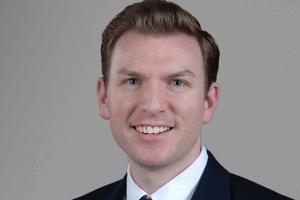
University of Virginia cardiothoracic surgery resident Dr. Evan Rotar will collaborate with UVA School of Medicine clinicians and UVA engineers to design a device that will help cardiac patients with severe heart failure.
The UVA Center for Engineering in Medicine will provide engineering-medicine research support, such as connecting Rotar with engineering expertise and helping to navigate between fields; the UVA Coulter Translational Research Partnership, which is led by the UVA Department of Biomedical Engineering, will provide guidance on regulatory processes, design and manufacturing.
“We’ve been embedding student and faculty engineers in the medical school, but now we’re switching directions. We’re excited to launch a fellowship that connects a surgical resident with an engineering team,” said Dr. Mark Sochor, director of the center, associate professor and vice chair of research for the Department of Emergency Medicine, medical director for the Center for Applied Biomechanics and associate professor of mechanical and aerospace engineering.
“I think so many researchers are eager to participate in these types of collaborations, and we’re providing them as fast as we can,” Sochor said. “We hope to continue expanding our offerings. And Coulter is a perfect fit as a partner. Not only does Evan receive research and device design assistance, but he also gets valuable mentorship to enhance his training with new skills and experiences.”
Rotar and his clinical mentor Dr. Leora T. Yarboro, a UVA associate professor of surgery and chief of cardiac surgery, have been trying to solve a problem for patients who have experienced heart failure and have needed a live-saving ventricular assist device, or VAD, implanted to keep their heart pumping. Some of the patients who receive the device don’t need it permanently because their heart gets strong enough to pump on its own. But the implant requires anchoring the device to the heart, thus making a hole.
The big question Rotar and Yarboro have been working on is: What do we do with the hole in the heart after the device is removed?
The team has already developed several early device prototypes that could work to either plug the hole or act as an access point for other assistive or monitoring devices. The innovative duo is excited about the next phase of their project, which will involve a strong partnership with UVA Engineering.
“We’re looking to expand our future prototyping using 3D printing technology and new materials,” Rotar said. “We are fortunate to have access to laboratory experimental models for rigorous prototype evaluation. We aim to complete the project and apply for patents within the year.
“We’ll be collaborating with biomedical engineering, but we are also interested in exploring mechanical engineering and materials science.”
The project plan also includes investigating the design of internal body sensors.
Rotar said his interest in engineering and design and their interaction with medicine stemmed from observation and asking why we do things a certain way and if they could be done differently or better.
“The simplicity of well-designed, effective, beautiful, intuitive objects or interfaces are not a thing of magic. They’re the byproduct of rigorous thought, attention to detail, repeated questioning and quest for improvement,” Rotar said.
“What makes Evan unique is his unrelenting passion to improve on what is known,” Yarboro said. “Evan has an incredibly inquisitive mind, which enables him to think outside the box and identify unique solutions to problems that others don't even see. His passion for the field of cardiothoracic surgery is balanced with the knowledge that he is working in a space that is ripe for innovation.”
“I aspire to the idea that you can individually impact several thousand patients over the course of a career, but by creating something new, you have the potential to affect exponentially more,” Rotar said.
Rotar’s drive for success is evident in his track record of achievements, including graduating magna cum laude with a bachelor’s degree in exercise science and nutrition from the University of Buffalo, achieving a 4.0 GPA in graduate school while getting his master’s at Case Western University for medical physiology, being inducted into the highly regarded Gold Humanism Honors Society during medical school at the University of Toledo, receiving best junior poster at Resident Research Day at UVA School of Medicine and being awarded the UVA Beller Grant, which sponsors innovation.
He has also attained national recognition by receiving the Thoracic Surgery Foundation Resident Research Award and being a member of the Society of Thoracic Surgery Workforce on Resident Issues.